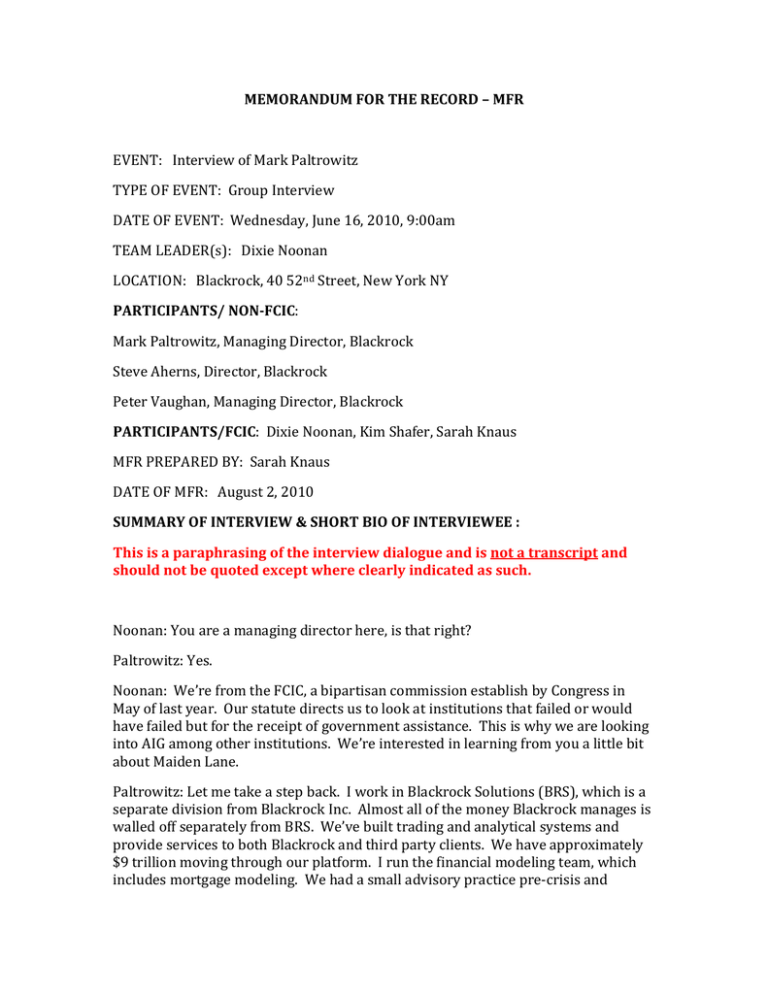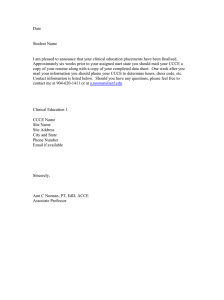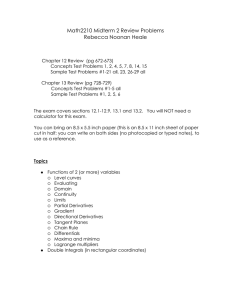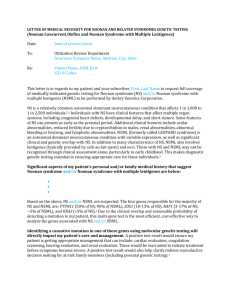MEMORANDUM FOR THE RECORD – MFR
advertisement

MEMORANDUM FOR THE RECORD – MFR EVENT: Interview of Mark Paltrowitz TYPE OF EVENT: Group Interview DATE OF EVENT: Wednesday, June 16, 2010, 9:00am TEAM LEADER(s): Dixie Noonan LOCATION: Blackrock, 40 52nd Street, New York NY PARTICIPANTS/ NON-FCIC: Mark Paltrowitz, Managing Director, Blackrock Steve Aherns, Director, Blackrock Peter Vaughan, Managing Director, Blackrock PARTICIPANTS/FCIC: Dixie Noonan, Kim Shafer, Sarah Knaus MFR PREPARED BY: Sarah Knaus DATE OF MFR: August 2, 2010 SUMMARY OF INTERVIEW & SHORT BIO OF INTERVIEWEE : This is a paraphrasing of the interview dialogue and is not a transcript and should not be quoted except where clearly indicated as such. Noonan: You are a managing director here, is that right? Paltrowitz: Yes. Noonan: We’re from the FCIC, a bipartisan commission establish by Congress in May of last year. Our statute directs us to look at institutions that failed or would have failed but for the receipt of government assistance. This is why we are looking into AIG among other institutions. We’re interested in learning from you a little bit about Maiden Lane. Paltrowitz: Let me take a step back. I work in Blackrock Solutions (BRS), which is a separate division from Blackrock Inc. Almost all of the money Blackrock manages is walled off separately from BRS. We’ve built trading and analytical systems and provide services to both Blackrock and third party clients. We have approximately $9 trillion moving through our platform. I run the financial modeling team, which includes mortgage modeling. We had a small advisory practice pre-crisis and created the Finance Management Analysis (FMA), which is wholly housed inside Blackrock Solutions (BRS). We are completely walled off and completely separate. We deal with some of the largest financial institutions with their trading and sensitive data. The advisory business is on a need to know basis. Often times clients are even Blackrock’s competitors in some ways. Noonan: So this isn’t money you’re managing? Paltrowitz: Within FMA, we built out and built up a team dramatically, which is dedicated to advisory services and advisory portfolio management. This team is responsible for Maiden Lane II and III. We advise assets under management, and specialize in working in and providing transparency to special situations for and complex assignments. Noonan: For example, Maiden Lane II and III they are what they are? Paltrowitz: They are. A large part of it is understanding each and every assets, and updating market analysis. Maiden Lane isn’t really an actively managed portfolio; it is hold not sell. Something like a CDO, there may be rights that go along with that because they’re RMBS. Vaughn: You’re getting well ahead of yourself. Noonan: To the extent that I don’t ask the right questions, please keep doing that. Paltrowitz: Maiden Lane is a separately housed portfolio managed team. Noonan: How did Blackrock come to manage those assets? Paltrowitz: We were hired by the Federal Reserve to manage them as they created Maiden Lane. Even prior to that we were brought in to advise them and give analysis on the assets’ collateral. Noonan: For example, you would say that this is a prudent loan because of quality? Paltrowitz: These are often mortgage assets. Maiden Lane is straight forward because it’s just RMBS. These are 30 year mortgages underlying the bonds. Often they are the most senior bonds, but the collateral hadn’t performed well. It was clear that the subprime bubble had burst, and home prices were down. The performance of the assets are subject to home price changes and homebuyer behavior. That’s what we were modeling. We would model a range of scenarios, with often the biggest factor being what the path of the home prices would be with changing interest rates and other inputs. To be transparent, we say our assumptions are x, and with these assumptions the assets will produce x cash flow. Noonan: Who at the Fed would you work with? Paltrowitz: Helen Mucciolo. There were different teams, I don’t remember the staffers. Vaughn: Who did you deal with originally in getting the assignment and setting up the structure? Paltrowitz: I don’t recall every individual. There were a bunch of people in working groups looking at tehse assets. From a legal side, we were hired with an IMA, Stephanie Heller was the point of contact for Blackrock. Vaughn: Who were you dealing with in terms of valuations, transparency, and estimates? Paltrowitz: In addition to the Fed, there were teams from Morgan Stanley and Davis Polk working on the project. Really, we provided guidance and were given input from the other people to come up with a range of cash flows and a modeling structure around that. Noonan: So Helen Mucciolo was the point person? Paltrowitz: She’s the one who runs the investment group there responsible for Maiden Lanes I, II, and III. She’s the chair of the investment committee that we interact with on a formal basis quarterly. Noonan: Kim is going to want to ask a lot more about the models, but my main reason that I’m interested in talking to you is because AIG’s problems turned out to be mark to market unrealized losses on the super senior CDS and security lending business, and also liquidity problems because of the collateral provisions. What we’ve been told is that there hasn’t actually been much of any economic loss to the assets. That’s my primary objective today, to learn what if any economic losses the assets have had. Have any of the CDO bonds in the Maiden Lane portfolio experienced default? Paltrowitz: They have. For the CDOs, what went into Maiden Lane III, these were long term CDS that AIG had written. If we look in the context of Maiden Lane III, it is straightforward: just the cash CDOs at market place at delivery. The structure was that the Fed made $24.3 senior loan and AIG made $5 billion junior loan. Noonan: So $29.3 was the market price? Paltrowitz: Yes, and roughly $63 billion par notional value. Shafer: They were all cash CDOs? Paltrowitz: Delivered in here. Shafer: So there may have been synthetic in AIG”s portfolio but didn’t become part of Maiden Lane II? Paltrowitz: Correct. In all of our estimates, we would have projected there would be losses from the $62.3 number. Shafer: You mean actual losses? Paltrowitz: When you say there’s a part of 62.3, it pays interest and principal. If there were no losses, in addition to the interest it would pay $62 billion back. It was clear at the time and today that that was not going to be the case. Clear to AIG, clear to the Fed, clear to any of our analysis. When we talk about the gap, there was the belief that the market value ($29 billion) overstated the loss that would be there if you could hold it to maturity. People were holding a larger discount rate than the coupons were. Trade to the discount of what would ultimately be.. Oftentimes the fed is concerned whether the payments were more or less than the 24 bllion. And so the statements that our projects show that the loan is adequately collateralized means that our payments will pay off the $24 billion. It’s not guaranteed or certain, but given the uncertainty of the assets and policy affects, it’s complicated. Given our best judgement, we wold think that the loan would be paid off. The waterfall reflects that. Lawyer: The question that kicked this off was that we gave advice on… Our best guess is that the cashflows will do that if home prices do this. Noonan: Can you give me an idea of what the economic losses have been so far? I’m interested in the magnitude. Lawyer: I think we would refer you to what the Fed has made publically available. Noonan: But they haven’t. We are here to find out if there are actually losses. AIG is telling us we could have rode this thing out. I’m trying to find out how accurate it is, how far off it is. Lawyer: Take a step back. There have been some defaults. Noonan: The events of default are a technical term. The CDO is a complicated contract with triggers that say if the value of the CDO fails to cover the values that are written. That will be a legal term in change of waterfalls. Active management: one of the things we are doing is advising the Fed on what their rights are. To the extent they have the rights for liquidation, we’ve had at least one liquidation event. You can substitute one piece with liqdui. Lawyer: We’re talking about realized losses. We now know there are only going to be cashflows for $90 million. A lot of these are projections. The CDO contracts don’t write down. On a mark to market basis, they are clearely under water. Noonan: I’m making a very concerted effot to not talk about mark to market. There’s still a wide range of uncertainty. Lawyer: If you realize a loss, that means that portion is not going to be recoverable. Noonan: What is the projection when you realize something, why is there an element of uncertainty to it? Paltowitz: There are probably some CDOs in Maiden Lane III, that are “money good” as AIG says. There are other CDOs in there where it certainly is not the case. The reason you follow it all the way down, you say that the loss may not have been crystallized, but the pool is still going down. Noonan: One way to look at it, I apologize because it’s an unfair question, you can look at the projections as of today and separately what you actually know has already happened. I understand your projection point because you have no idea if the homeowner is going to pay the balance of the loan. I get that. Today, what we already know and what has already happened. Lawyer: So what are we talking about here? Noonan: Just III. Paltrowitz: For III, I think the statement is technically correct that there have been little crystallized losses. That is still basically a true statement today. However, it’s disingenuous that even when Maiden Lane III was created in 2008, projections would have significant losses. Noonan: I’m not asking for actual dollar amounts. Based on what you know now, are the projections of the economic losses going to be on a certain portion of the portfolio? Shafer: Go ahead and state the range of the assumptions if it makes it easier to explain. Lawyer: If you want to talk technical details we’re happy to do so. I want to refer back to the Fed’s statements of what is there. Shafer: I recognize that you have been trained, schooled and have a great responsibility to your clients, but our job is actually to intervene in that and to ask questions and to ask for confidential information which we then have the responsibility to keep confidentiall. That is our job. I sense this professional reflex that I respect, but please understand what our role is. Lawyer: I don’t know what it’s responsive to. Shafer: Just referring always to the Fed. Noonan: What I took that to mean is that the market vaue for Maiden Lane at creation is $29 billion, the bonds is $62 billion, you believe there is sufficient collateral of the $24 billion. I take that to mean that you don’t expect losses of more than 50%. The projected economic losses are somewhere between 0-50%? Paltrowitz: But I think that is a given. Let me put one thing in the background. These are second derivatives. One change can cause the CDO cash flows to change dramatically. That’s where you underwrite to down scenarios. We think there’s sufficient collateral once you run it all the way through. The $24 billion has gone down over time because there have been payments since it started. The range can be pretty wide. Projected range. We think a lower boundary will be $24 billion, the upside could be $10-15 or $20 billion, but not full recovery. Somewhere between 25-50%. It’s hard to make that statement, it’s subject to lots of caveats. I think it’s my own professional judgement and not even Blackrock’s opinion. Noonan: You anticipate the economic losses to be at least 25%? Patrowitz: I think that given the time we’ve spent over there, that the Fed and AIG and ourselves would view that if we would recover only 25% loss it would exceed expectations. We would be highly satisfied that lots of fundamentals in the American economy are better than expected. Noonan: Just a couple more questions. Lawyer: I just don’t want you to say Blackrock says 25%. Noonan: We will talk offline about public disclosure. This is from the Fed’s website, showing the distrobution. Shows 79% as BB+ and lower. So I’m clear, the CDO bonds started out as SS? Patrowitz: SS refers to structure, not rating. SS meaning they’re the highest of the waterfall. When the underlying collateral is going to have losses, the rating agency standard are if the bond would recover 99 cents on the dollar but take a dollar loss would be CCC or lower. The rating scheme is not what’s the depth of the loss. Noonan: Is this referring to the CDO bonds or the underlying RMBS bonds? Paltrowitz: This looks like its referring to the underlying CDS bonds. Noonan: Would they have been rated? Paltrowitz: They were all initially AAA. Talk to Moody’s. Noonan: I just wanted to make sure. Paltrowitz: Is there a chance there were some AA? There could be. Shafer: Do you know was there in each case another AAA tranche below the AIG exposure? Paltrowitz: I think many of the deals had mezzanine, but I don’t know it was all. I think what ended up happening was wrapping. They would have gone all the way to the top. The important thing is that they were wrapping up to the X tranche. Laywer: is the rating downgrade unique to this portfolio? (No. The ratings even at the time were just lagging. It was irrelevant and had no bearing on the analysis.) Noonan: Is Blackrock’s portfolio objective to hold the assets to maturity or liquidate or simply to liquidate..? Paltrowitz: It’s a dual mandate, first in context of insuring full payback of the loan. First paying back full value. It’s not to wrap it up as soon as its liquidated to pay off the loan immediately. Our mandate is specifically at the direction of the Fed. The strategy has been hold now. If and when we get certainty on the full payment, the maximized value is sell off. Personally I think the Fed would rather get out earlier and get some upside rather than hold them for 30 years, but is prepared to to maximize value. Noonan: How is the portfolio making payments to the Fed? Paltrowitz: The assets are all cashflowing. The CDOs have interest payments themselves. Even if the assets don’t pay down themselves, there’s still . Still reclassed interest. There are principal payments being made, they’re just going through the waterfall. Noonan: I want to go through similar questions about Maiden Lane II. Shafer: When you first were called in, I’d like to understand some of the range of modeling assumptions… were the drivers of what you used and subsequently how you would have migrated those over time. Not to get into every assumption but the ones that drove the value. Paltrowitz: At the time we started looking at these assets in summer and fall 2008, BR’s assumptions were not customized for the portfolio, we model RMBS loan performance at the loan level. We roll it up and use the proprietary models to index the RMBS waterfalls. Feed it back again to the CDO waterfall to come up with cashflows. The primary driver is home prices. We do our home price projections, looking back at Case-Shiller data. Realized home price depreciation at the home price estimate on the home loan. We have to state level projections going forward. Noonan: And those were based on your econometric models? Paltrowitz: Yes. So while there was a lot of custom work around particular CDOs and looking at the swaps before the structure, and making sure you have all of the right cashflows, the assumption hasn’t moved that much. We were already pretty bearish in Fall 2008. It was clear we were in the throws of a crisis. National average, tiered by geography underneath there. I don’t have in front of me when we changed the different projections, but we were always. We have a suite of models. Noonan: Your expertise was in… so you were looking for a ballpark? Paltrowitz: In the fall, we were around… The trough of home prices came in spring 2009. We were in freefall for a few quarters. The actual data would be first quarter or second quarter. When we talk about a base, it was conservative but not draconian. Probably around 6% peak to trough. Noonan: The assumption is in? Paltrowitz: Home price. Home price in the US peaked and from that level, probably down 20% in the fall of 2008. We had further projections. In the final quarters of 2008 and first quarter 2009 got down to 31%. We were still projecting declines, now we’re projecting around 34%. We had wider variance in the fall of 2008, which is more important. The severe case that we projected then is worse than we would today. At the time we probably would have had a wider range. It would have been reasonable that it could have been V-shaped. Noonan: V-shaped? Paltrowitz: Imagine that fall 2008 there’s crazy stimulus and home prices stop dropping and home prices recover. If you recall at that time there were forecasts that unemployement would get to 8%. Those impact these models. To credibly say I’m this bullish and optimistic. You could have been in the realm of possible. Tere’s less upside of the assets today. Noonan: How would unemployment rate affect? Paltrowitz: The key driver is default rate. When we model it’s what’s the voluntary prepayment rate. We’ve had very little of that. Our key driver is how fast is the default. What’s the ability to pay. Our models are not quite that granular. Higher unemployment, higher default rates. Worse home prices is direct severity. Stress scenario, home prices go down 35%, less severity. Noonan: What you’re looking at is projecting defaults and rate of defaults? Paltrowitz: Yes. It’s what’s the rate of default and the loss of default. Even if the borrower just leaves and stops making payments, the bank gets fair value and the property doesn’t deteriorate much. Some of the uncertainty is that the time line takes longer. The HAMP and other programs that haven’t worked so well, by the time the borrower ultimately gets foreclosed upon, the longer the home price is the higher the losses. Time to liquidation, which has not been great news, it’s in our forecast. Noonan: Have your prepayment assumptions changed materially? Paltrowitz: At the first order level, we’ve been on our base path. In some cases, including home prices, we’ve been a little better than forecast two years ago. Less prepayment. The severities are higher than we would have forecast. All in, first order, our base assumptions are pretty close. Sometimes we’d say there’s a base and stress. First order, the models have held up pretty well. Not just used here, throughout BRS. Noonan: And commercial real estate? Paltrowitz: We have a similar process looking at CMBS underlying loans. In some ways those are the better quality assets. I think there’s been disclosure. There’s something called project max, which is a better than average deal in the portfolio. Not because we’re not bearish, just because the structures are better. Noonan: Depreciation of value… Paltrowitz: Depending on which index you’re looking at, we’re already down 45% and not dissimilarly to what we would have projected. The base price still has a weakness but not velocity. The real question becomes exactly how the rollover will get handled with them coming due. It will make these cashflows longer than we had anticipated and increased the range of outcomes. If there were a double dip you could have a worse outcome. There are paths that these assets can do okay. Noonan: My semi-precise question was have you changed in a material way the driving assumptions? Paltrowitz: No, I don’t think so. We’ve been able to refine things around the headline, so we haven’t been surprised by the path over the last year or two. Noonan: So your expectations were roughly in the order of 45% then? Paltrowitz: And continue to be. Noonan: If we could talk about Maiden Lane II, securities lending RMBS. The magnitude of the realized losses, both what we know now and what’s been projected. Paltrowitz: It was a market value of 28 billion with a $19.5 senior and $1 billion junior loan. Roughly $40 billion notional, just over 50 cents on the dollar at the time. This is simpler because this is just one level of structure inside of there. You can see the Fed’s response from the standpoint that there’s a good measure of they provided equity there and only a billion here. Depending on what the losses were coming through to be. The first order probably wasn’t that different. In stress cases we were underwriting and the downside , it’s the case that these assets we would project them to have losses and continue to. If they recover to a $30 billion total that would be seen as an upside. It doesn’t mean that they can’t do better. Lawyer: When you say the performance could be good it’s based off of your best case scenario? Paltrowitz: Again, the center range would have been higher than the 50%, although we thought the downside would have… Lawyer: That was at the time? Paltrowitz: Both at the time and today. These are 30 year loans. The uncertainty comes from the fact of how will they be dealt with. Principal forgiveness, extend the loans longer. The tranche warfare where the servicer is taking all of the fees for themselves and you have collateral. Noonan: You have subordination? Paltrowitz: It’s expected to be very little. If you look at the rating chart, all of the AAA securities have been downgraded and if they haven’t then they should have been. There’s a notion of how do I know that . Some chance it pays off at par. Noonan: Roughly 25-50%? Paltrowitz: There may be more upside. Noonan: 20-45? Paltrowitz: Something like that. Noonan: The only other question is the valuation methods you used. One of the things we’ve looked at is how they determined the fair value of the assets. I would appreciate your opinion on how you go about assessing the market value of the underlying assets? Paltrowitz: Maiden Lane II is more straightforward. The process that we use and that the Fed discloses as the fair value is a FAs 157 compliant methodology where we’re trying to find out where.. reasonable size on a margin in the market. In Maiden Lane II, we have the ability to get third party marks, so we follow Blackrock’s standard. We have an indepent pricing team. Some are services, level II marks. We don’t take them blindly. The assumption would be to use it if it’s in a reasonable range. You could have two identical bonds miles apart with level II marks. We come up with a Blackrock method based on prices in the market. We use our models to translate the market exit prices and translate into real prices. To the extent we use our best guess cashflow to say here is all of the different cash flows, you come up with a base cash flow which says here are the 200 firm transactions that help us fill out the .. appropriate discount rates on those bonds. Without credible third party marks, we find the closest benchmark. The model is a tool. Noonan: Does that mean there’s a liquid market for these? Paltrowitz: If we get real executions, those get the most rate. We have more real executions that we would have had at the depth of the crisis. The process is the same. To give you a sense, at the depths of the crisis you may have firmwide. That may be only a point or two wide markets. The indications are trying to say what is the fair value. For the RMBS it’s easier. A good chunk of the portfolio is level 2, but there are level 3 prices inside of there. For Maiden Lane III there are no direct variables. There are a couple of ways to get similar answers. The easiest is to look at the underlying CDS, you know the average yield. Add on some liquidity extra spread. Noonan: That makes the price lower? Paltrowitz: Yes. Lower value, higher yield. Shafer: At the time some of the CDOs were created, the opposite were created. (And some of it is an improper value to the structure.) Paltrowitz: For Maiden Lane III, it’s the same process without direct observables. You use the direct observables for the underlying RMBS. They also have ABS, and loans, and CLOs. The other way of doing it is there are indications of CDOs that trade. You come out the other way trying to understand that hedge funds will play $25 million pieces in these. It’s not a 100% dead market, just a mostly dead market. Which is why they’re still the mark to market which is below what the intrinsic may be. Noonan: Ballpark, what’s the discount rate you’re using? Do you have a different discount rate for each CDO? Paltrowitz: In the process, just because of adjustments inside of there, when you use a static cash flow analysis, you can make adjustments. Low double digits, 1015% today, at the heart of the crisis probably 15-20%. Significant yields. Noonan: Could you repeat? Paltrowitz: On the appropriate, conservative base adjusted cash flows, at the heart of the crisis we were looking at 15-20% IRRs on average, with certain higher than 20. Those have come ina little bit. For well structured cashflows they’re around 15%. Noonan: That means you get the marks for the underlying assets in the CDO bond, you value them, and then you discount the value? Paltrowitz: No. Those assets given their price and loss adjusted cashflows imply a yield. If you pay 50 cents today you get the 50 cents but a compound return of 10 cents. We might use 13% discount rate on the CDO. There’s some leakage, but you have subordination. Noonan: So it sounds like there is some inclusion of the CDO with the cashflows? Paltrowitz: The key is that many of the CDOs should have a coupon of LIBOR +20. You’re assuming 20% ….there’s a 30% difference between the intrinsic and the recovery off these base adjusted cashflows. 4837-8715-5719, v. 1




![Lymphatic problems in Noonan syndrome Q[...]](http://s3.studylib.net/store/data/006913457_1-60bd539d3597312e3d11abf0a582d069-300x300.png)